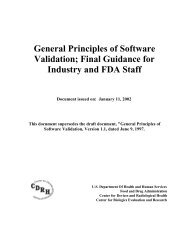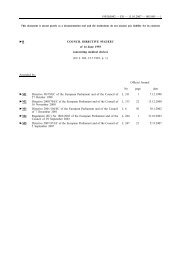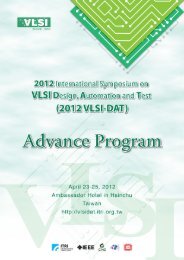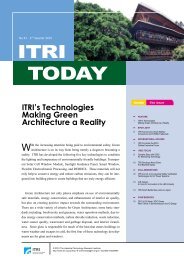Design Control Guidance - Food and Drug Administration
Design Control Guidance - Food and Drug Administration
Design Control Guidance - Food and Drug Administration
Create successful ePaper yourself
Turn your PDF publications into a flip-book with our unique Google optimized e-Paper software.
INTRODUCTIONI. PURPOSEThis guidance is intended to assist manufacturers in underst<strong>and</strong>ing quality systemrequirements concerning design controls. Assistance is provided by interpreting thelanguage of the quality systems requirements <strong>and</strong> explaining the underlying concepts inpractical terms.<strong>Design</strong> controls are an interrelated set of practices <strong>and</strong> procedures that are incorporatedinto the design <strong>and</strong> development process, i.e., a system of checks <strong>and</strong> balances. <strong>Design</strong>controls make systematic assessment of the design an integral part of development. As aresult, deficiencies in design input requirements, <strong>and</strong> discrepancies between the proposeddesigns <strong>and</strong> requirements, are made evident <strong>and</strong> corrected earlier in the developmentprocess. <strong>Design</strong> controls increase the likelihood that the design transferred to productionwill translate into a device that is appropriate for its intended use.In practice, design controls provide managers <strong>and</strong> designers with improved visibility of thedesign process. With improved visibility, managers are empowered to more effectivelydirect the design process—that is, to recognize problems earlier, make corrections, <strong>and</strong>adjust resource allocations. <strong>Design</strong>ers benefit both by enhanced underst<strong>and</strong>ing of thedegree of conformance of a design to user <strong>and</strong> patient needs, <strong>and</strong> by improvedcommunications <strong>and</strong> coordination among all participants in the process.The medical device industry encompasses a wide range of technologies <strong>and</strong> applications,ranging from simple h<strong>and</strong> tools to complex computer-controlled surgical machines, fromimplantable screws to artificial organs, from blood-glucose test strips to diagnosticimaging systems <strong>and</strong> laboratory test equipment. These devices are manufactured bycompanies varying in size <strong>and</strong> structure, methods of design <strong>and</strong> development, <strong>and</strong> methodsof management. These factors significantly influence how design controls are actuallyapplied. Given this diversity, this guidance does not suggest particular methods ofimplementation, <strong>and</strong> therefore, must not be used to assess compliance with the qualitysystem requirements. Rather, the intent is to exp<strong>and</strong> upon the distilled language of thequality system requirements with practical explanations <strong>and</strong> examples of design controlprinciples. Armed with this basic knowledge, manufacturers can <strong>and</strong> should seek outtechnology-specific guidance on applying design controls to their particular situation.When using this guidance, there could be a tendency to focus only on the time <strong>and</strong> effortrequired in developing <strong>and</strong> incorporating the controls into the design process. However,readers should keep in mind the intrinsic value of design controls as well. It is a wellestablishedfact that the cost to correct design errors is lower when errors are detectedearly in the design <strong>and</strong> development process. Large <strong>and</strong> small companies that haveachieved quality systems certification under ISO 9001 cite improvements in productivity,product quality, customer satisfaction, <strong>and</strong> company competitiveness. Additional benefitsIntroduction 3/11/97 Page 1
















